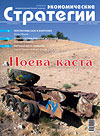Noah’s Caste
Opening address of editor-in-chief.

Opening address of editor-in-chief.
The article deals with regulating relations in the energy sector within the framework of the Eurasian Economic Union, provisions of the Treaty on the Eurasian Economic Union dated 29 May 2014 in the energy field, cooperation prospects of Member States in the energy sector. The brief analysis of the “Energy” section of the Treaty of May 29, 2014 is done.
In work integrated (synergetic) approach to a problem of evolution of national (state) idea is used. In him mathematical modeling, the dynamic theory of information and the concept of civilizations are combined. It allows to define accurately the concept “national idea” and to track his role in evolution of society. The special attention is paid to a situation in modern Russia.
In the last period every year the global economy was increasingly dependent on the pace of China’s economy development, on which many countries have traditionally pinned their hopes for successful exit from the crisis. 2015 has clearly and unequivocally demonstrated the tendency of Chinese critical instability increase. There are many reasons, and one of the most important was the change in the US policy — termination of “quantitative easing” programs, which determines conditions of demand for Chinese goods and the volume of their exports. Once and for all the credit character of “successful” China’s economic growth became apparent, the possibility of obtaining the effect from realizing the model of financial incentives to China’s national economy through increasing the volume of loans and investments is almost exhausted. The main conclusion: there is a direct correlation between the consequences of investment and industrial glut in China due to extreme economic growth and strengthening of structural economic and financial disproportions laying the contours of inevitably arising from them a new round of Chinese and the global economic crises.
The main challenge is the lack of specialists with core competencies in the development of new types of weapons.
The article deals with modern military conflicts, as well as characteristics and peculiar features of strategic offensive culture. This culture always presupposes the existence of struggle elite, a single civil-military corporation capable of spiritual strategic goal setting and as a result — relying on the unity of the state and non-state national security systems, on a single complex — “total forces” — which combines public and private forces ensuring security policy, NPOs that directly interact with them, political parties and movements, religious institutions, mass media and business structures. Public-private paramilitary units of a new type, meeting the requirements of conducting asymmetric and hybrid wars, gradually become the core of this complex.
The author examines the concept of “hybrid warfare”, compares definitions of this notion, given by different foreign researchers. He analyzes the methods of hybrid wars waging that correlate with certain armed conflicts that took place in the XIX-XX centuries.
Exactly information wars are at the heart of the hybrid war.
The article deals with approaches to disclosure of the nature and the causes of the armed conflict in Chechnya, existing in modern historiography. The paper considers versions interpreting the circumstances that caused forceful intervention of the federal forces in the Chechen conflict on the side of anti-Dudayev opposition. It also highlights the causes versions and underlying reasons of beginning the counter-terrorist operation in the Chechen Republic.
We want to trace the evolution of the Universe objects from the very beginning.